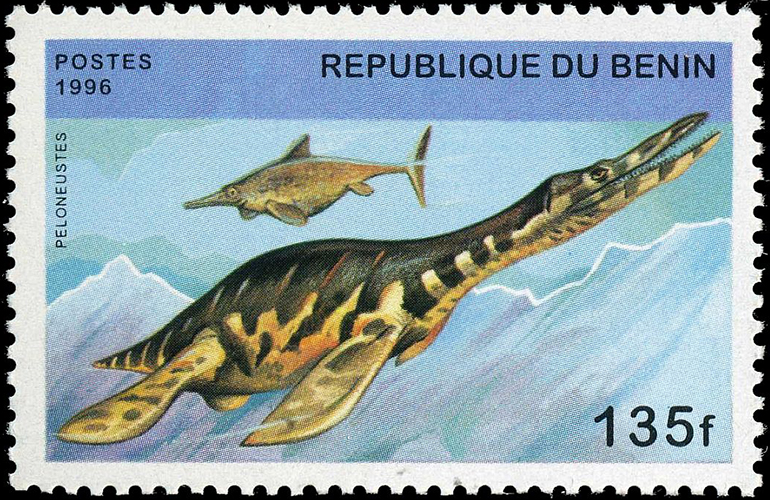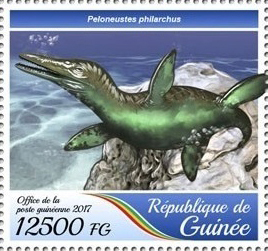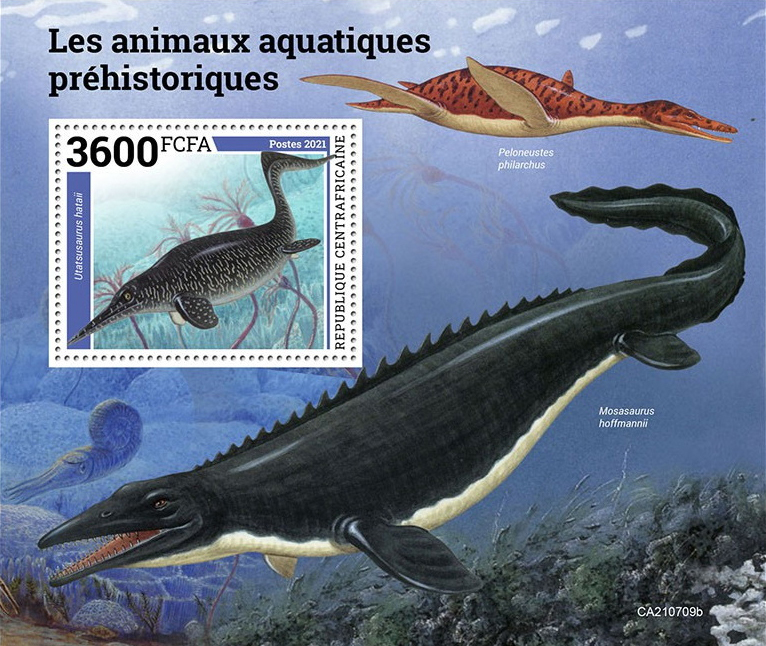Peloneustes philarchus Seeley, 1869

Phylum: Chordata Haeckel, 1874
Subphylum: Vertebrata Cuvier, 1812
Classe: Reptilia Laurenti, 1768
Ordine: Plesiosauria de Blainville, 1835
Famiglia: Pliosauridae Seeley, 1874
Genere: Peloneustes Seeley, 1869
Descrizione
Lungo circa tre metri, questo animale appartiene al gruppo estinto dei plesiosauri, rettili marini che dominarono i mari nel Giurassico e nel Cretaceo. Il peloneuste, in particolare, era un rappresentante dei pliosauroidi, ovvero i plesiosauri a collo corto. La testa del peloneuste era lunga e le mascelle erano robuste e armate di denti aguzzi, perfette per afferrare e trattenere i pesci di cui questo animale si nutriva. Il corpo non era molto idrodinamico ma tozzo, come quello di molti pliosauri, e la coda era corta. In compenso, le quattro zampe trasformate in “pagaie” erano notevolmente efficaci per direzionarsi durante il nuoto. Il peloneuste doveva essere un forte nuotatore, che vagava per i mari del Giurassico alla ricerca di pesci e cefalopodi. I suoi nemici principali erano altri pliosauri dalle dimensioni ben più grandi, come lo stesso Pliosaurus o Liopleurodon.
Diffusione
Vissuto nel Giurassico superiore in Europa.
Sinonimi
= Plesiosaurus philarchus Seeley, 1869 = Thaumatosaurus philarchus Lydekker, 1888 = Pliosaurus philarchus Seeley, 1892 = Peloneustes philarchus var. spathyrhynchus Linder, 1913.
Bibliografia
–Cohen, K.M.; Finney, S.; Gibbard, P.L. (2015). "International Chronostratigraphic Chart" (PDF). International Commission on Stratigraphy.
–Ketchum, H. F.; Benson, R. B. J. (2011). "The cranial anatomy and taxonomy of Peloneustes philarchus (Sauropterygia, Pliosauridae) from the Peterborough member (Callovian, Middle Jurassic) of the United Kingdom". Palaeontology. 54 (3): 639-665.
–Seeley, H. G. (1869). Index to the fossil remains of Aves, Ornithosauria, and Reptilia, from the secondary system of strata arranged in the Woodwardian Museum of the University of Cambridge. Cambridge, Deighton, Bell, and co. pp. 139-140.
–Creisler, B. (2012). "Ben Creisler's Plesiosaur Pronunciation Guide". Oceans of Kansas.
–Araújo, R.; Smith, A. S.; Liston, J. (2008). "The Alfred Leeds Collection of the National Museum of Ireland - Natural History" (PDF). Irish Journal of Earth Sciences. 26: 17-32.
–Andrews, C. W. (1910). A descriptive catalogue of the marine reptiles of the Oxford clay. Based on the Leeds Collection in the British Museum (Natural History), London. Vol. 1. London: British Museum.
–Tarlo, L. B. (1960). "A review of the Upper Jurassic pliosaurs". Bulletin of the British Museum (Natural History). 4 (5): 145-189.
–Lydekker, R. (1889). "On the remains and affinities of five genera of Mesozoic reptiles". The Quarterly Journal of the Geological Society of London. 45 (1-4): 41-59.
–Seeley, H. G. (1892). "The nature of the shoulder girdle and clavicular arch in Sauropterygia". Proceedings of the Royal Society of London. 51: 119-151.
–Andrews, C. W. (1913). A descriptive catalogue of the marine reptiles of the Oxford clay. Based on the Leeds Collection in the British Museum (Natural History), London. Vol. 2. London: British Museum.
– Andrews, C. W. (1895). "On the structure of the skull of Peloneustes philarchus, a pliosaur from the Oxford Clay". Annals and Magazine of Natural History; Zoology, Botany, and Geology. 16 (93): 242-256.
–Jaccard, F. (1907). "Notes sur le Peloneustes philarchus Seeley du musée paléontologique de Lausanne". Bulletin de la Société Vaudoise des Sciences Naturelles (in French). 43 (160): 395-398.
–Linder, H. (1913). "Beiträge zur Kenntnis der Plesiosaurier-Gattungen Peloneustes und Pliosaurus". Geologische und Palaeontologische Abhandlungen (in German). 11: 339-409.
–Andrews, C. W. (1910). "Note on a mounted skeleton of a small pliosaur, Peloneustes philarchus Seeley". Geological Magazine. 7 (3): 110-112.
–Phillips, J. (1871). Geology of Oxford and the valley of the Thames. Oxford: Clarendon Press.
–Lydekker, R. (1890). Catalogue of the fossil Reptilia and Amphibia in the British Museum (Natural History). Part IV. Containing the orders Anomodontia, Ecaudata, Caudata, Labyrinthodonta; and supplement. London: Trustees of the British Museum. p. 273.
–Knutsen, E. M. (2012). "A taxonomic revision of the genus Pliosaurus (Owen, 1841a) Owen, 1841b" (PDF). Norwegian Journal of Geology. 92: 259-276.
–Novozhilov, N. (1948). Two new pliosaurs from the Lower Volga beds Povolzhe (right bank of Volga)] (PDF). Doklady Akademii Nauk SSSR (in Russian). 60: 115-118.
–Storrs, G. W.; Arkhangel'skii, M. S.; Efimov, V. M. (2000). "Mesozoic marine reptiles of Russia and other former Soviet republics". In Benton, M. J.; Shishkin, M. A.; Unwin, D. M.; Kurochkin, E. N. (eds.). The Age of Dinosaurs in Russia and Mongolia. Cambridge, UK: Cambridge University Press. pp. 187-209.
–O’Keefe, F. R. (2001). "A cladistic analysis and taxonomic revision of the Plesiosauria (Reptilia: Sauropterygia)". ActaZoologica Fennica. 213: 1-63.

|
Data: 30/08/1996
Emissione: Animali preistorici Stato: Benin |
|---|

|
Data: 25/08/2017
Emissione: Animali preistorici acquatici Stato: Guinea Nota: Emesso in un foglietto di 4 v. diversi |
|---|

|
Data: 29/01/2021
Emissione: Gli animali preistorici acquatici Stato: Central African Republic Nota: Presente nel foglietto |
|---|